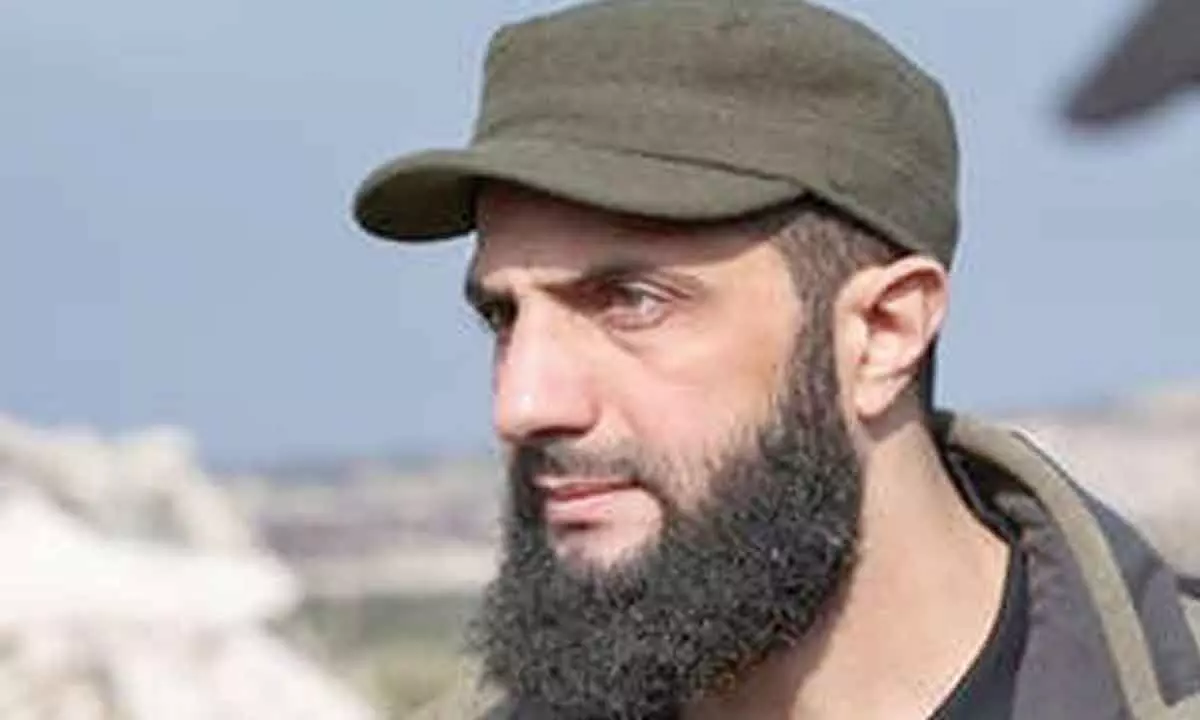Live
- CPM demands Rs 15k Rythu Bharosa aid
- Global meet in Manipal to explore ancient wisdom and modern therapy
- Homage paid to victims of Tirupati stampede
- Splendour marks Teppotsavam in Bhadrachalam
- Tirumala dazzles with colourful decorations
- Talpagiri temple decked up for Ekadasi
- 358th ‘Prakash Purab’ of Guru Gobind Singh to be held on Sunday
- IGP inspects police selections
- Triple-R displaced ryots hold protest
- TTD issues 1.2 lakh Vaikunta Dwara Darshan tokens
Just In

Syrian Islamist rebels, led by the jihadist Hayat Tahrir al-Sham (HTS), stormed the capital of Damascus on Sunday to overthrow President Bashar al-Assad.
Damascus: Syrian Islamist rebels, led by the jihadist Hayat Tahrir al-Sham (HTS), stormed the capital of Damascus on Sunday to overthrow President Bashar al-Assad. Hayat Tahrir al-Sham (HTS) chief Abu Mohamed al-Jolani is the leader of the Islamist rebel alliance that spearheaded an offensive in late November 2024 that brought down President Bashar al-Assad and ended five decades of Baath Party rule.
The rebels had cleared their intention to use “all available means” to overthrow Assad and declared Damascus free of the “tyrant” once the President fled the capital.
Abu Mohammed al-Jolani has gained worldwide attention as his strategic moves managed to bring an end to the long-drawn Syrian civil war and topple Assad in less than two weeks.
Jolani is a former extremist who adopted a more moderate posture to achieve his goals. They credited Jolani’s changed attire to his moderation in ideology. The HTS chief has stopped sporting the turban worn by jihadists, often favouring military fatigues instead.
On Wednesday, Jolani donned a khaki shirt and trousers to visit Aleppo.
“He is a pragmatic radical. In 2014, he was at the height of his radicalism,” Thomas Pierret, a specialist in political Islam, said, referring to the period of the war when Jolani’s HTS sought to compete with the jihadist Islamic State group. “Since then, he has moderated his rhetoric,” he added.
Once operating from the shadows, Jolani has given interviews to the international media and delivered statements that have attracted the attention of millions of Syrian refugees living abroad. Born in 1982, the 42-year-old Jolani was raised in Mazzeh, an upscale district of Damascus, and remained good in academics. The 9/11 twin tower attacks in the US were the first episode to turn Jolani’s attention towards jihadist thinking.
Jolani shared immense admiration for the attackers and began attending secretive sermons and panel discussions in marginalised suburbs of Damascus.
He left Syria to join al-Qaeda in Iraq to fight the US when it invaded the country in 2003. The terror outfit, then led by Abu Musab al-Zarqawi, reportedly detained Jolani for five years and prevented his rise through the ranks of the terror outfit.
In March 2011, when ‘pro-democracy’ protests broke against Assad’s rule in Syria, Jolani returned home and founded the Al-Nusra Front, Syria’s branch of al-Qaeda.
In 2013, he refused to swear allegiance to Abu Bakr al-Baghdadi, who would go on to become the emir of the Islamic State group and instead pledged his loyalty to al-Qaeda’s Ayman al-Zawahiri.
In 2015, Jolani claimed that he had no intention of attacking the West and called for Assad to be defeated. He also called for protecting the Alawite minority that Assad belongs to from revenge attacks by other groups.
Jolani decided to cut ties with al-Qaeda to prevent Western countries from targeting his organisation. Analyst speaking to AFP described the move as strategic and a start to chart his path as a statesman.
In 2017, Jolani merged with HTS and other Islamist groups in northwest Syria to bring vast areas of Idlib province that had slipped out of Assad’s control. Under its watch, the HTS developed a civilian government and provided a semblance of stability while crushing rival groups. In this phase, the HTS was accused by residents and rights groups of brutal abuse against dissidents, which the UN has classified as a “war crime”. Aware of the group’s past, Jolani assured the residents of Aleppo, which houses a sizeable Christian minority, that they would face no harm under his ‘regime’. He also called on his fighters to preserve security in the areas they had “liberated” from Assad’s rule.

© 2025 Hyderabad Media House Limited/The Hans India. All rights reserved. Powered by hocalwire.com







